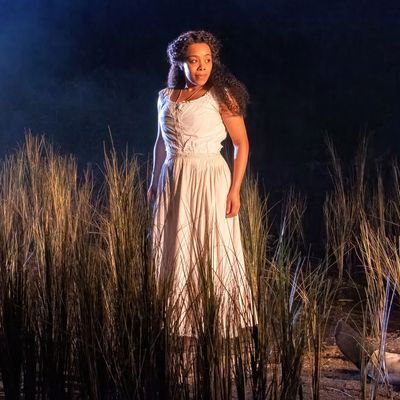
Most playwrights wind up forgotten. Alice Childress was briefly successful during her lifetime—one of her plays, Wedding Band (subtitle: A Love/Hate Story in Black and White) was frequently produced and even turned into a television movie in 1974 starring Ruby Dee— but in subsequent years she slipped from public view, ignored by even academics and historians. But when that lost fame returns, it returns all in a rush. Childress is not just being revived now but renowned, her plays finding their place in the canon three decades after her death.
Harking back to a story she claimed her grandmother told her, Childress set Wedding Band in 1918 in Charleston, where interracial relationships were illegal. Despite the prim shirtwaist dresses on her characters, the playwright wasn’t talking about a distant past. (The play is from 1963; the Supreme Court wouldn’t rule on Loving v. Virginia until 1967.) Both Wedding Band and Childress’s other masterpiece, Trouble in Mind, had been proposed for Broadway productions in her lifetime, but queasy producers didn’t follow through once the playwright refused to soften her language — Childress wouldn’t dull her blade to get to the Big Time. You can see why they worried. She cuts deep with Wedding Band, exposing anti-Blackness down at the American bone. Childress writes that love isn’t a cure for it, and neither is the judicial corrective that she could see coming. One of our finest theatrical diagnosticians, she traces racism’s creeping gangrene as the play goes forward, finding it everywhere, in white hearts and in Black minds too.
It’s Julia Augustine’s tenth anniversary with her beau, and she’s just moved into a new neighborhood. She’s hopeful, but she’s also braced against what the neighbors will think — Julia (Brittany Bradford) is Black, and her lover, Herman (Thomas Sadoski), is white. Herman officially lives at home with his viperish mother (Veanne Cox) and weak-willed sister (Rebecca Haden), but because of the relationship, Julia has been moving constantly, hounded and rejected each time she tries to settle down in a Black community. Still, she hopes her latest set of neighbors — all tenants of the grasping Fanny (Elizabeth Van Dyke) — will be different this time. Perhaps spiritual Lula (Rosalyn Coleman) will understand, or her proud son Nelson (Renrick Palmer), whose service in the Great War has made him a target of jealousy and white anger. Maybe Mattie (Brittany-Laurelle) will sympathize, smitten as she is with her husband, who’s off on a battleship somewhere, writing her letters she cannot read.
Childress is particularly good at showing us complexity in just a few strokes. Her core couple is as worn-in as an old shirt — the excellent Bradford and Sadoski play the longevity of their relationship by seeming both warmly easy and a little unlistening. When Herman finally realizes that staying in South Carolina has become unbearable to Julia, he promises that they’ll leave, but you also hear the echo of a decade of misheard conversations. He falls ill with the Spanish flu, and the fever brings all kinds of unwelcome visitors — his disgusted family as well as revenants in his own mind, long-buried racist language he learned as a child.
Childress is an unswayable realist; she doesn’t believe in any progress that requires the participation of white society. When Julia tells Nelson his service will mean advancement for the race — “On account-a you … they’re gonna take down the no-colored signs” — even she doesn’t think it’s the truth. “If you just gotta believe somethin,’ it mays well be that,” she tells him, grimly. Childress does, though, believe a woman can tear injustice out of her own life by the roots. We see reflections of this capacity in the other characters, in, for instance, Lula’s insistence on building her own version of a religious service, one that doesn’t need a church. You start on the patch of earth where you stand; you cast out what does not serve you.
In the elegant production at Theater for a New Audience, the director Awoye Timpo deliberately blurs the edges of the play. Alphonso Horne’s hypnotic jazz compositions melt the borders of each scene away from the real. The theater has been arranged into alley seating, with long rows of seats on either side of a median covered in dirt and fringed with tall seagrass. At one end of this central strip, Julia’s furniture and suitcases huddle against the grass’s soft fringe. It’s an abstract idea of Franny’s property: When people enter and leave Julia’s small rented house, there’s no door, no porch, no lighting shift. Even the interior’s placement doesn’t stay consistent. Sometimes when people are standing in the middle of the playing area they’re in the house, sometimes they’re not.
Clearly Timpo, set designer Jason Ardizzone-West, and lighting designer Stacey Derosier have thought about the South Carolina Lowcountry marshland. It’s a tidal place (the set provides this too), both salt and fresh. At the end of this production of Wedding Band, a white-clad Julia splashes calf-deep in water that has seeped up through the soil — you’ll be reminded of movies like Julie Dash’s Daughters of the Dust, in which Gullah women dance against the same kind of estuarial backdrop. In the salt marsh, the liquid world always finds a way in, no matter what you do to keep it out. So it’s a thought-provoking (and extremely beautiful) setting for Childress’s ideas about other seeping things — a mysterious, fog-in-the-light sort of place.
Childress’s plot, though, needs literal boundaries to make its storytelling clear. According to the dialogue, we are very much in town. Julia has found the country lonely and has come back to live among people— in Franny’s back yard, with its groomed lawn and close-clustered rental houses, specifically. Her door and its wall, both made invisible here, are also important for our understanding of what’s at stake in each scene. When she can and can’t keep people outside matters to Julia, and when people (particularly Herman’s bloodless mother) step inside, it should feel like the moment when a vampire crosses a threshold. All safety ends.
The setting demonstrates a pivot in the attention of this particular show, away from Wedding Band’s world and into the thoughts it provokes. Sometimes production and text work hand-in-hand, as it does with Coleman’s Lula and Palmer’s Nelson, who play with such deeply felt complexity, you can imagine the whole parallel life they’re living just offstage, and in Cox’s terrifying creation of a sick old woman kept alive by her own bile. There’s a little slippage, though, in how Timpo handles the immensely tricky transformation of Julia. Childress’s text is bleak. It finishes by finding a way for the couple to be together, for only a moment, Julia murmuring to Herman about a fantasy that they’ll never achieve. But given our last glimpse of Julia in this production (dancing in a shaft of light, water sparkling in an arc overhead), Timpo is less interested in that ambivalent escape and more in healing Julia Augustine, in finding her personal transcendence and spiritual ecstasy. To stage this, Timpo brings Julia over to the side of the stage where Lula has been conducting her religious ceremonies, where the women have sung together in community. Julia (and Timpo) find hope over there, wading in the water. The image is gorgeous; the joy is palpable. They just have to hush the play a little to create it.
Wedding Band is at Theatre for a New Audience’s Polonsky Shakespeare Center through May 22.





